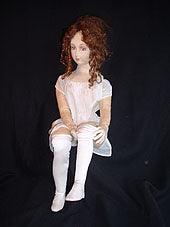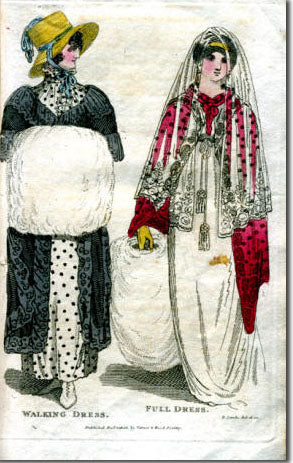Displaying the Latest Fashions
When I read the following quote from Sense and Sensibility, I wondered in what way the wedding clothes were displayed at the warehouse.
"The rest of Mrs. Palmer's sympathy was shown in procuring all the particulars in her power of the approaching marriage, and communicating them to Elinor. She could soon tell at what coachmaker's the new carriage was building, by what painter Mr. Willoughby's portrait was drawn, and at what warehouse Miss Grey's clothes might be seen."

Though head forms of paper Mache or wicker were used for hats and wigs, the invention of the mannequin and the hanger were more than a half century away. How then, were Miss Grey's clothes displayed? There are several possible methods. The dresses may have been suspended from pegs using the pair of ribbon loops sometimes included in better clothing even today. We currently use them to help hold gowns on the hanger by looping the ribbons over the hook of the hanger, but the ribbon loops are the relic of a time when gowns were hung from two pegs. Another method of display was to pass a dowel through the arm holes and suspend the ends of the dowel in holders or from a pair of knotted cords. Finally clothes might be laid out on white linen on a table. In the early part of the nineteenth century, before the invention of photography, fashion conscious women relied on prints of drawings of clothing in such fashionable magazines as La Belle Assemblee, The Lady's Magazine, and Ackerman's Repository . Other methods of viewing the latest fashions included: fashion dolls dressed in the latest mode, viewing the wedding clothes of the ton at warehouses, or watching the elite enter the theater. I imagine the traffic generated at a cloth warehouse by women coming to view the wedding clothes of the about to be married Ton misses benefited sales. Perhaps a discount was given on cloth if the clothing was displayed at the cloth warehouse. Cost of Cloth in 1791 1 yard of good poplin cost 3 schillings 2 pence (tuppence). Wholesale cost of 168 yards of crape was 12 guineas and 14 schillings.
Sharon Wagoner is the webmistress of The Georgian Index. Visit her site for a treasure trove of little known information about the Georgian period. A fascinating collection!
If you don't want to miss a beat when it comes to Jane Austen, make sure you are signed up to the Jane Austen newsletter for exclusive updates and discounts from our Online Gift Shop.
 Though head forms of paper Mache or wicker were used for hats and wigs, the invention of the mannequin and the hanger were more than a half century away. How then, were Miss Grey's clothes displayed? There are several possible methods. The dresses may have been suspended from pegs using the pair of ribbon loops sometimes included in better clothing even today. We currently use them to help hold gowns on the hanger by looping the ribbons over the hook of the hanger, but the ribbon loops are the relic of a time when gowns were hung from two pegs. Another method of display was to pass a dowel through the arm holes and suspend the ends of the dowel in holders or from a pair of knotted cords. Finally clothes might be laid out on white linen on a table. In the early part of the nineteenth century, before the invention of photography, fashion conscious women relied on prints of drawings of clothing in such fashionable magazines as La Belle Assemblee, The Lady's Magazine, and Ackerman's Repository . Other methods of viewing the latest fashions included: fashion dolls dressed in the latest mode, viewing the wedding clothes of the ton at warehouses, or watching the elite enter the theater. I imagine the traffic generated at a cloth warehouse by women coming to view the wedding clothes of the about to be married Ton misses benefited sales. Perhaps a discount was given on cloth if the clothing was displayed at the cloth warehouse. Cost of Cloth in 1791 1 yard of good poplin cost 3 schillings 2 pence (tuppence). Wholesale cost of 168 yards of crape was 12 guineas and 14 schillings.
Though head forms of paper Mache or wicker were used for hats and wigs, the invention of the mannequin and the hanger were more than a half century away. How then, were Miss Grey's clothes displayed? There are several possible methods. The dresses may have been suspended from pegs using the pair of ribbon loops sometimes included in better clothing even today. We currently use them to help hold gowns on the hanger by looping the ribbons over the hook of the hanger, but the ribbon loops are the relic of a time when gowns were hung from two pegs. Another method of display was to pass a dowel through the arm holes and suspend the ends of the dowel in holders or from a pair of knotted cords. Finally clothes might be laid out on white linen on a table. In the early part of the nineteenth century, before the invention of photography, fashion conscious women relied on prints of drawings of clothing in such fashionable magazines as La Belle Assemblee, The Lady's Magazine, and Ackerman's Repository . Other methods of viewing the latest fashions included: fashion dolls dressed in the latest mode, viewing the wedding clothes of the ton at warehouses, or watching the elite enter the theater. I imagine the traffic generated at a cloth warehouse by women coming to view the wedding clothes of the about to be married Ton misses benefited sales. Perhaps a discount was given on cloth if the clothing was displayed at the cloth warehouse. Cost of Cloth in 1791 1 yard of good poplin cost 3 schillings 2 pence (tuppence). Wholesale cost of 168 yards of crape was 12 guineas and 14 schillings.



Leave a comment
This site is protected by hCaptcha and the hCaptcha Privacy Policy and Terms of Service apply.